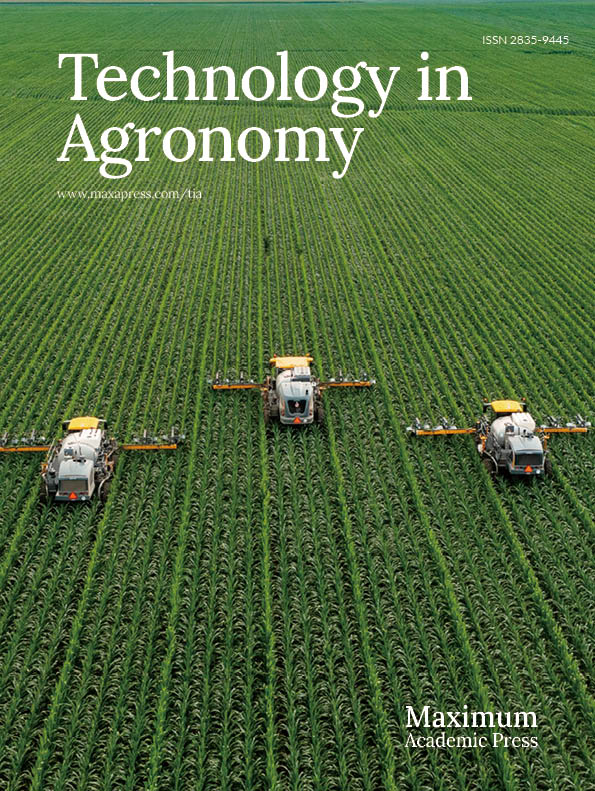-
Assessing the degradation of a specific soil and the long-term viability of a particular agricultural practice based on chemical, physical, and biological factors is referred to as 'soil health'[1]. Soil health that is physically impoverished can be identified by reduced water infiltration, increased surface runoff, inadequate root penetration, and insufficient aeration. Acidification, salinization, and heavy nutrient leaching are a few attributes of chemically degraded soil[2]. Multiple strategies were presumed for restoring degraded soil, including amending with organic manure, compost, leafy manure, vermicompost, and various soil amendments[3]. Whereas organic amendments improve the soil health and fertility[4], high decomposition rate of organic manure in tropical climates is only possible through the continuous application of organic amendments[5]. This creates a huge challenge for farmers due to the large quantity requirements and associated high costs in application for perennial plants. As biochar contains a high proportion of recalcitrant carbon that can contribute to the biological cycling of nutrients, it is a promising and cost-effective option for rehabilitating less fertile soils[6].
-
Biochar often referred to as 'Black Gold' is a promising soil amendment used in agriculture that enhances crop productivity and reduces the need for fertilizer[7]. The UK Biochar Research Centre has defined it using a broader term; 'porous solid carbon material produced thermo chemically converting organic matter in a minimal oxygen condition and which is physiologically suitable to store C and improve soil'[8]. Biochar has been used as an amendment in many cropping systems to improve soil health, soil fertility, crop productivity, and cleaning of contaminated water and agricultural soils[9−11]. In general, it improves soil fertility by modifying the soil physical, chemical, and biological properties, consequently maximizing crop growth and yield.
-
Literature demonstrates that biochar amendment improves soil nutrient availability through the liming effect and accelerated decomposition of soil organic matter[10,12−14]. Biochar improves total N, P, and CEC availability while lowering toxic metal availability[7,15−17] in addition, it increases soil pH which enhances the nutrient availability to the plants[18]. It has been discovered that biochar was effective in absorbing
${\text{NH}^+_4} $ ${\text{NH}^-_3} $ ${\text{NO}^-_3} $ ${\text{PO}^-_4} $ -
Biochar application to soil enhances the water-holding ability of soil due to its intensely high surface area and porosity[21]. According to Blanco-Canqui, biochar is more responsive in sandy soils than clayey soils[22]. Moreover, biochar application reduces bulk density, tensile strength, increases soil porosity, wet aggregation, water availability, soil consistency, regulates water infiltration, saturated hydraulic conductivity, and dry soil aggregation[23−27]. Blanco-Canqui has discovered the smaller the particle size, the greater the water holding capacity and lower the saturated flow[22].
-
Biochar promotes increased microbial activity in soil by mediating soil physicochemical properties, supplying electrons, and leading to the formation of habitats[28]. Biochar is a rich source of carbon, nutrients, and moisture, which promotes the growth of soil microorganisms and in due course stimulates plant-microbe interaction[29]. Warnock et al. have found an abundance of mycorrhizal fungi in the presence of biochar due to enhanced soil properties and interfering microbial interactions[30]. In addition to providing a large surface area for microbial habitats, it was evidenced that biochar stimulates the secretion of sensing chemicals for nutrient absorption and desorption and regulates the exudation of allelochemicals and toxic compounds[12].
-
The characteristics of biochar have inevitably contributed to an increase in productivity. According to Jeffery et al., biochar amendment increased crop yield by an average of 25% in tropical soils, but not in temperate soils where biochar application induced liming, thus reducing fertilizer costs and greenhouse gas emissions[10]. Biochar application further improves water and fertilizer use efficiency by conserving water, reducing fertilizer losses, and absorbing heavy metals and toxic contaminants in the soil, all of which have an impact on long-term crop productivity[20,31]. Finally, biochar absorbs carbon dioxide (CO2) from the atmosphere by converting the intense C pool (crop residues or trees) to an inert carbon pool[13]. When being incorporated into the soil, biochar quickly oxidizes, allowing higher rate of available organic C absorption. Higher molecular weight and complex nature of newly attached external compounds, block the micro pores (less than 2 nm) in outer surface layer of biochar structure, reducing active surface area for microbial activities and decomposition. As a result of that, decomposition rate of biochar is slower in tropics compared to other conventional organic amendments types and lasts longer in the soil.
Sorrenti discovered that using different rates (0–30 t/ha) of wood-derived biochar had no effect on yield and fruit quality of Kiwi and Nectarine grown in temperate regions[32]. Biochar and compost blends produced at rates of 10 t/ha and 25 t/ha, respectively, have enhanced the trunk diameter and number of shoots of apple seedlings[33]. Besides that, Abo-Ogiala reported that a 20 t/ha rate of biochar application improved plant growth, fruit quality, and productivity of banana, a semi-perennial crop[34]. In a two-year experiment conducted by Gondim et al., the irrigated water requirement for coconut seedlings was also reduced by applying coconut husk biochar at rates of 0.5–4 kg/plant[35].
-
The use of biochar in agriculture has increased over the last decade. Biochar improves soil carbon sequestration and productivity in weathered tropical soils by lowering bulk density, intensifying water-holding capacity and nutrient retention, sustaining soil organic matter, prompting microbial activity, and triggering nutrient availability while trapping heavy metals. Given all of these pluses, biochar may be a promising amendment for use on tropical soils to increase the productivity of perennial crops grown on potentially degraded lands.
-
The data and material during the current study are available from the corresponding author on reasonable request.
-
Authors greatly acknowledge Coconut Research Institute of Sri Lanka and three anonymous reviewers for the comments that significantly improved the quality and scope of this manuscript.
-
The authors declare that they have no conflict of interest.
- Copyright: © 2023 by the author(s). Published by Maximum Academic Press, Fayetteville, GA. This article is an open access article distributed under Creative Commons Attribution License (CC BY 4.0), visit https://creativecommons.org/licenses/by/4.0/.
-
About this article
Cite this article
Dissanayake DKRPL, Dissanayaka DMNS, Udumann SS, Nuwarapaksha TD, Atapattu AJ. 2023. Is biochar a promising soil amendment to enhance perennial crop yield and soil quality in the tropics?. Technology in Agronomy 3:4 doi: 10.48130/TIA-2023-0004
Is biochar a promising soil amendment to enhance perennial crop yield and soil quality in the tropics?
- Received: 19 December 2022
- Accepted: 10 March 2023
- Published online: 03 April 2023
Abstract: Soil quality improvement is crucial in tropical soils to enhance crop productivity. Organic matter incorporation is not a viable approach regarding perennials as it completely degrades within a year. Hence, biochar is a sustainable solution to boost crop productivity in the tropics. Biochar has been utilized in agriculture for decades due to its inherent properties that enhance the soil-mediated properties associated with soil fertility. The impact of biochar on tropical perennial intensive cropping systems has been understudied, possibly because of the high initial input demand. This paper highlights the facts related to soil chemical, physical, and biological property enhancement upon biochar incorporation relating to long-term impacts on perennial crops.
-
Key words:
- Biochar /
- Crop yield /
- Perennial crop /
- Soil quality /
- Tropical












